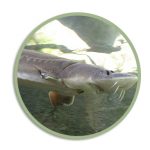White Sturgeon
 Columbia River Basin sturgeon managers engaged in the StreamNet Executive Committee have indicated it would be valuable to shared standardized HLIs through the Coordinated Assessments Partnership (CAP). StreamNet and the CAP Core Team are tasked, as resources permit work to advance, to conduct a scoping exercise for a White Sturgeon abundance indicator, similar to natural-origin spawner abundance (NOSA) for salmon and steelhead.
Columbia River Basin sturgeon managers engaged in the StreamNet Executive Committee have indicated it would be valuable to shared standardized HLIs through the Coordinated Assessments Partnership (CAP). StreamNet and the CAP Core Team are tasked, as resources permit work to advance, to conduct a scoping exercise for a White Sturgeon abundance indicator, similar to natural-origin spawner abundance (NOSA) for salmon and steelhead.
Background
The Five-Year Plan for the Coordinated Assessments Partnership outlines an approach for conducting a scoping exercise to inform development of a White Sturgeon abundance indicator:
- Further definition is needed before proceeding to development. Once this is completed, at a meeting of the StreamNet Executive Committee (SN ExCom), the proponents of this indicator will describe the purpose of this indicator and how it would be used.
- If directed to proceed by the SN ExCom, StreamNet and the CAP Core Team will request the assistance of the PNAMP Fish Monitoring Workgroup (FMWG) to facilitate a broader discussion with relevant experts in the Basin to further explore this topic. This discussion should inform what content/data would be available to support this indicator and agreement on methods to calculate this indicator.
- PSMFC StreamNet staff will convene a core group of the CAP Data Exchange Standard (DES) Development Team (CAP DDT) to draft a general outline of a DES table for the White Sturgeon indicator.
- StreamNet and the CAP Core Team will then convene a small group of fisheries managers to discuss and report back to the SN ExCom and seek their approval to go forward. If approved, the Fish Monitoring Workgroup and the CAP DDT will develop and finalize the DES table for this indicator.
The 2020 Addendum to the NPCC Columbia River Basin Fish and Wildlife Program also identifies a regional need for tracking progress toward meeting White Sturgeon biological objectives for abundance (objective WS1), spatial distribution (objective WS2), genetic diversity (objective WS3), and productivity (objective WS4) derived from sturgeon management plans across the region. The NPCC states that contributing to achieving these White Sturgeon adult abundance targets, as well as other population characteristics, serves in the absence of quantitative goals and objectives based in hydropower loss assessments.
Workshop and Events
See PNAMP Fish Monitoring Work Group webpage for related events.
White Sturgeon Documents
| File | Description | File Date |
|---|---|---|
| Five-Year Plan for Coordinated Assessments Partnership 2nd revision of the 2019 adopted version (rev Nov 2022) | This is the 2nd revision of the Five-Year Plan for Coordinated Assessments Partnership adopted in 2019. This November 2022 revised version incorporates edits discussed and supported during the StreamNet Executive Committee meeting on September 21, 2022. | 2022 |
| Five-Year Plan for the Coordinated Assessments Partnership adopted 20190731 (revised 9Sept2021) | Revised version of the Five-Year Plan for the Coordinated Assessments Partnership adopted in 2019 and revised in 2021 during the September 9, 2021 Executive Committee meeting. This updated version of the plan describes the hatchery indicator work that is ongoing through the HCAX project, updates the approach for adding new content about the available of data for salmon and steelhead populations without CAP Fish HLIs and /or trends data, and updates the CRITFC ITMD project description. | 2021 |
| Five-Year Plan for the Coordinated Assessments Partnership (v. 20200902) | Sep 2, 2020 Executive Committee Meeting – Five-Year Plan for Coordinated Assessments Partnership (v. 20200902) | 2020 |
| Five-Year Plan for the Coordinated Assessments 2019 | 2019 updated version of the Five Year Plan for Coordinated Assessments | 2019 |
| Five-Year Plan for the Coordinated Assessments 2018 | 2018 updated version of the Five Year Plan for Coordinated Assessments | 2018 |
| Five-Year Plan for the Coordinated Assessments 2017 | 2017 updated version of the Five Year Plan for Coordinated Assessments | 2017 |
| Five-Year Plan for the Coordinated Assessments 2015 | 2015 Five Year Plan for Coordinated Assessments | 2015 |

